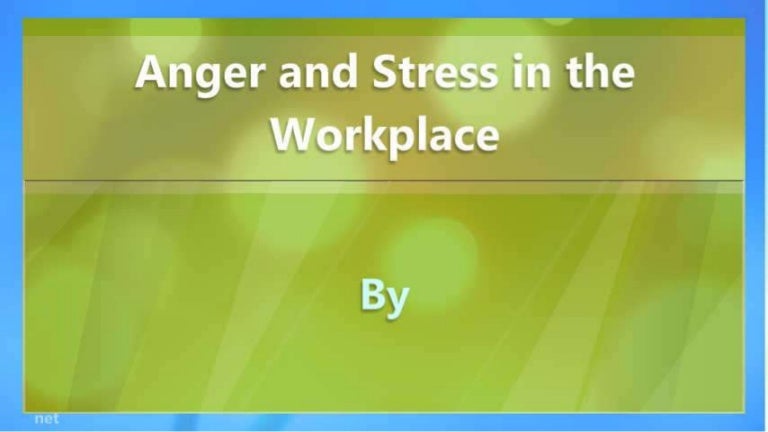
Understanding Angers Workplace Impact
Understanding the meaning impact of anger in the workplace is crucial for fostering a productive and positive environment. This exploration delves into the various facets of anger, from its definition and triggers to its effects on individual performance, team dynamics, organizational culture, and leadership. We’ll also discuss effective strategies for managing anger and the vital role leadership plays in creating a supportive and anger-aware work atmosphere.
Anger, a common human emotion, can manifest in the workplace in many ways. Understanding the different expressions of anger, from passive-aggression to open outbursts, is key to effectively addressing the issues it can cause. This exploration also identifies common workplace stressors that can fuel anger and explores how these factors affect individuals, teams, and the organization as a whole.
Defining Anger in the Workplace
Anger, a fundamental human emotion, can manifest in the professional sphere in various ways. Understanding its nuances, triggers, and expressions is crucial for fostering a healthy and productive work environment. Recognizing the difference between healthy and unhealthy responses to anger is vital for managing conflicts and maintaining positive relationships with colleagues and superiors.Anger in the workplace is a complex emotion that arises from a variety of stimuli.
It’s not inherently negative, but its intensity and expression can significantly impact productivity, communication, and overall well-being.
Defining Anger in a Professional Context
Anger in a professional setting is a strong emotional response characterized by feelings of frustration, hostility, or antagonism. It’s triggered by perceived injustices, unmet expectations, or challenging situations. A key aspect is the context – the emotional response is in relation to the professional interactions and expectations of the workplace.
Distinguishing Healthy and Unhealthy Anger
Healthy anger is a controlled and constructive response to perceived injustice. It allows for open communication, resolution of conflicts, and assertive expression of needs without harming others. Unhealthy anger, conversely, is characterized by explosive outbursts, passive-aggressive behaviors, or suppressed emotions, leading to damaging consequences for individuals and the work environment.
Triggers of Anger in the Workplace
Several factors can trigger anger in the workplace. These include unreasonable deadlines, unfair workloads, inadequate resources, interpersonal conflicts, and a lack of recognition or appreciation. Poor communication, conflicting expectations, and a perceived lack of control over one’s work can also contribute significantly to feelings of anger.
Anger Reaction Styles
| Anger Reaction Style | Description | Example |
|---|---|---|
| Passive-Aggressive | Indirect expression of anger through subtle sabotage, procrastination, or passive resistance. | A team member consistently completes tasks late or makes mistakes, even though they were previously praised for their accuracy. |
| Outbursts | Sudden and intense expressions of anger, often involving yelling, aggressive language, or physical displays of frustration. | A project manager shouts at a team member during a meeting, criticizing their work publicly. |
| Suppressed Anger | Holding back anger, often resulting in resentment, frustration, and stress. | An employee consistently agrees with a colleague’s suggestion, even though they have a better alternative, simply to avoid conflict. |
Common Workplace Stressors and Anger
| Workplace Stressors | Explanation |
|---|---|
| Unrealistic Deadlines | Demands exceeding reasonable time constraints. |
| Unfair Workloads | Unequal distribution of tasks or expectations. |
| Inadequate Resources | Insufficient tools, support, or materials to complete tasks. |
| Interpersonal Conflicts | Disagreements or tension with colleagues or superiors. |
| Lack of Recognition | Absence of acknowledgment for contributions. |
| Poor Communication | Ineffective or unclear information exchange. |
| Conflicting Expectations | Different or unclear expectations from various sources. |
| Lack of Control | Limited autonomy or influence over work tasks. |
Impact on Individual Performance

Anger in the workplace, though often overlooked, significantly impacts individual performance. It disrupts focus, diminishes productivity, and can even lead to long-term consequences. Understanding the nuances of this impact is crucial for fostering a healthier and more productive work environment.Uncontrolled anger can manifest in various ways, from passive-aggressive behavior to explosive outbursts. These reactions can hinder an individual’s ability to complete tasks effectively, leading to decreased efficiency and errors.
This, in turn, can negatively affect team dynamics and project outcomes.
Effects on Productivity and Efficiency
Anger significantly hinders productivity. When individuals are consumed by anger, their minds are preoccupied with negative emotions, making it challenging to concentrate on tasks at hand. This emotional turmoil disrupts the cognitive processes necessary for effective problem-solving and decision-making. Consequently, tasks are often completed with decreased accuracy and speed. Furthermore, anger can lead to procrastination and avoidance of work-related responsibilities, further diminishing overall productivity.
Impact on Different Roles and Responsibilities
The effects of anger vary based on the role and responsibilities within a team. For example, a customer service representative experiencing anger might lash out at clients, damaging the company’s reputation. Conversely, a project manager experiencing anger might become overly critical of team members, stifling creativity and collaboration. A senior executive, consumed by anger, could make rash decisions that negatively impact the entire organization.
The specific impact depends on the individual’s position and the nature of their responsibilities.
Correlation Between Anger Management and Job Satisfaction
Effective anger management is directly linked to higher job satisfaction. When individuals can manage their anger effectively, they can maintain a positive and constructive attitude towards work. This positive mindset fosters better relationships with colleagues and superiors, leading to a more fulfilling and satisfying work experience. Conversely, uncontrolled anger can create a hostile work environment, contributing to stress, anxiety, and ultimately, lower job satisfaction.
The ability to manage emotions is a key component of overall job satisfaction.
Potential Long-Term Consequences of Uncontrolled Anger
Uncontrolled anger in the workplace can have detrimental long-term consequences. Chronic anger can lead to burnout, impacting physical and mental health. It can also damage professional relationships, making it difficult to build trust and collaborate effectively with colleagues. Furthermore, repeated outbursts can lead to disciplinary actions, potentially jeopardizing career advancement opportunities. The consequences of uncontrolled anger often extend beyond the immediate situation, impacting both the individual and the organization.
Strategies for Managing Anger to Improve Focus and Performance
Effective anger management strategies can significantly improve focus and performance. Techniques such as deep breathing exercises, mindfulness practices, and cognitive restructuring can help individuals identify and manage triggers. Seeking professional counseling or therapy can provide additional support and strategies for coping with anger effectively. Regular breaks, healthy lifestyle choices, and maintaining a healthy work-life balance can also contribute to better emotional regulation.
Impact on Team Dynamics
Anger in the workplace, while a natural human emotion, can significantly disrupt team dynamics, hindering productivity and creating a hostile environment. Understanding its impact on cohesion, communication, and morale is crucial for fostering a positive and productive work atmosphere. Uncontrolled anger can poison the well of teamwork, leading to misunderstandings and conflict.
Impact on Team Cohesion and Collaboration
Team cohesion, the glue that binds a group together, is often weakened by anger. When individuals feel threatened or attacked by anger, they may withdraw, becoming less willing to cooperate and contribute. This can create a climate of fear and distrust, stifling creativity and collaboration. Team members might avoid interacting with the angry individual, leading to further isolation and fracturing of the team’s unity.
Communication Breakdowns in Anger-Related Conflicts
Anger frequently disrupts communication, making constructive dialogue impossible. When individuals are angry, they are often more focused on expressing their frustration than on actively listening or understanding the other person’s perspective. This leads to a breakdown in communication, where messages are misconstrued, and intended meaning is lost. This creates a cycle of negativity, where anger begets more anger.
A lack of clear and respectful communication can lead to serious conflicts that damage the team dynamic.
Examples of Anger Leading to Misunderstandings and Conflict, Understanding the meaning impact of anger in the workplace
A project manager, frustrated by a team member’s missed deadline, lashes out, accusing them of incompetence. This outburst, rather than addressing the issue constructively, creates resentment and hinders the team’s ability to work together. Another example is when a colleague, feeling overlooked, expresses their anger in a passive-aggressive manner, undermining the team’s efforts without direct confrontation. These scenarios demonstrate how easily anger can escalate into conflict, jeopardizing team performance and relationships.
Communication Styles and Anger Management
Different communication styles react differently to anger. Understanding these styles and their potential triggers can help manage anger-related conflicts effectively.
| Communication Style | Description | Relationship to Anger Management |
|---|---|---|
| Assertive | Direct and respectful, expressing needs and opinions clearly without aggression. | More likely to avoid anger escalation; fosters open communication. |
| Passive | Avoids expressing needs and opinions, often resulting in resentment and frustration. | Anger can build up, leading to potential outbursts or passive-aggressive behaviors. |
| Aggressive | Direct but disrespectful, expressing needs and opinions with hostility. | Anger is the primary mode of communication, leading to conflicts and damaged relationships. |
| Passive-Aggressive | Indirectly expressing anger or resentment, often through subtle actions or behaviors. | Anger is expressed subtly, leading to misunderstandings and frustration in team members. |
Impact of Anger on Team Morale
Anger significantly impacts the overall morale of a team. A hostile work environment, characterized by frequent displays of anger, can lead to feelings of anxiety, stress, and decreased job satisfaction. This, in turn, can negatively affect productivity, motivation, and employee retention. Teams experiencing consistent anger often see a decline in overall morale and team spirit.
Impact on Organizational Culture

Anger in the workplace isn’t just a personal issue; it profoundly impacts the overall atmosphere and culture of a company. Uncontrolled expressions of anger can create a toxic environment, negatively affecting employee morale, productivity, and ultimately, the company’s bottom line. A culture of fear and negativity often emerges when anger is not effectively managed.Uncontrolled anger can lead to a noticeable decrease in productivity.
Employees may become hesitant to take risks, communicate openly, or collaborate effectively. The fear of reprisal or conflict can stifle innovation and creativity, leading to a less productive and efficient work environment. This is a significant concern as a company’s success hinges on its employees’ ability to work together productively.
Impact on Company Reputation
Negative emotions, including anger, can significantly damage a company’s reputation. Instances of public displays of anger by employees or management can create a negative perception of the company’s values and professionalism. This can deter potential clients, investors, and employees, ultimately impacting the company’s brand image and ability to attract and retain talent. For example, a CEO publicly berating an employee in a meeting could severely damage the company’s image, especially in the social media age where such events can rapidly go viral.
Leadership Styles and Anger Expression
Leadership styles play a crucial role in how anger is expressed and managed within an organization. Authoritarian leadership styles, where decisions are made unilaterally and dissent is discouraged, often foster a climate where anger is more likely to be displayed. Conversely, collaborative and supportive leadership styles promote open communication and constructive feedback, reducing the likelihood of anger outbursts.
A leader who models emotional intelligence and actively listens to concerns can mitigate the impact of anger on team dynamics and the overall work environment.
Comparison of Positive and Negative Impacts of Anger
| Aspect | Positive Impacts (Potential, but usually minimal and short-lived) | Negative Impacts |
|---|---|---|
| Employee Motivation (Hypothetical) | In some rare cases, a focused outburst of anger can serve as a catalyst for a rapid change or push for improvement. | Usually, anger leads to decreased motivation, fear, and a lack of trust. |
| Decision-Making (Hypothetical) | Rarely, an expression of anger can stimulate quick decisive actions, if handled appropriately. | More commonly, anger leads to impulsive and irrational decisions. |
| Team Dynamics (Hypothetical) | In very specific situations, anger might prompt a team to confront an issue directly, but rarely leads to positive results. | More often, anger causes conflict, disharmony, and a decrease in collaboration. |
| Organizational Culture (Hypothetical) | In extremely rare instances, a calculated expression of anger might lead to immediate action and result in positive changes, however, it is highly unlikely. | Generally, anger fosters a toxic culture of fear and mistrust. |
“A culture of fear and negativity often emerges when anger is not effectively managed.”
Strategies for Managing Anger
Anger, a natural human emotion, can significantly impact workplace productivity and well-being. Understanding how anger manifests and its potential consequences is crucial for developing effective management strategies. A productive workplace requires strategies that address anger constructively, fostering a more positive and supportive environment.
Active Listening in Conflict Resolution
Active listening is a cornerstone of effective conflict resolution, particularly when anger is involved. It goes beyond simply hearing the words; it involves fully understanding the speaker’s perspective, including their emotions and underlying concerns. This involves paying close attention to both verbal and nonverbal cues. A crucial component of active listening is paraphrasing and reflecting back the speaker’s message to confirm understanding.
By demonstrating genuine interest in the other person’s point of view, active listening creates a safe space for open communication and de-escalates tension.
De-escalating Anger in the Workplace
Recognizing the early signs of escalating anger is essential for de-escalation. These signs might include raised voices, clenched fists, or sudden changes in body language. When you observe these signs, it’s crucial to respond promptly and calmly. A simple technique is to acknowledge the other person’s feelings, using phrases like “I understand you’re frustrated” or “It sounds like you’re really upset about this.” Creating a safe space for the individual to express their feelings without interruption allows them to vent their emotions and de-escalate the situation.
Effective Conflict Resolution Involving Anger
Conflict resolution involving anger necessitates a structured approach. A first step is to separate the individuals involved if the situation becomes overly heated. Creating a calm and neutral environment is paramount. Next, focus on understanding the root cause of the conflict. Engage in open communication, ensuring both parties have the opportunity to express their perspectives without interruption.
Employing active listening techniques can significantly contribute to a constructive dialogue. Mediation, if necessary, can facilitate a productive resolution by providing a neutral third party to guide the conversation. Crucially, a focus on finding a mutually agreeable solution is essential.
Improving Communication and Reducing Workplace Tension
Open and honest communication is vital in reducing workplace tension. Clear communication channels, where individuals feel comfortable expressing their concerns, are essential. Regular team meetings, one-on-one check-ins, and opportunities for constructive feedback are all effective strategies for improving communication. When discussing sensitive topics, it’s vital to employ empathetic communication, actively seeking to understand different viewpoints. This approach fosters respect and builds trust, reducing potential conflict and promoting a more harmonious work environment.
Promoting a Culture of Respect and Emotional Intelligence
Cultivating a culture of respect is essential for managing anger effectively. This involves creating an environment where diverse perspectives are valued and individuals feel comfortable expressing their emotions. A culture that embraces emotional intelligence empowers employees to understand and manage their own emotions, as well as recognize and respond to the emotions of others. Training programs that focus on emotional intelligence and conflict resolution skills are valuable assets for promoting a culture of respect.
Leaders should model emotional intelligence by actively demonstrating empathy, understanding, and fairness in their interactions.
Leadership Role in Anger Management

Effective leadership in the workplace extends beyond strategic planning and performance reviews. A crucial aspect of successful leadership is fostering a healthy emotional environment where employees feel comfortable expressing themselves without fear of reprisal. This includes actively managing and mitigating anger issues, both in oneself and among team members. A leader who models appropriate anger management techniques sets the stage for a more productive and harmonious work atmosphere.Leadership plays a pivotal role in establishing a culture of emotional intelligence and healthy conflict resolution.
By proactively addressing anger issues, leaders create a more supportive and less stressful work environment, leading to improved employee well-being and ultimately, enhanced organizational performance.
Importance of Leadership Example
Leaders are the primary role models for their teams. Their actions, both in managing their own emotions and in addressing the anger of others, significantly impact the overall emotional climate. When leaders demonstrate composure and effective communication strategies in the face of anger, they create a ripple effect, encouraging similar behavior among their team members. This sets the stage for a culture of respect and understanding.
A leader who frequently loses their temper or reacts inappropriately to frustration can inadvertently normalize anger within the team, leading to a toxic work environment.
Addressing Anger Issues Within Teams
Proactive strategies are essential in managing anger issues within teams. Leaders should establish clear communication channels and guidelines for dealing with disagreements and conflict. These channels should include accessible and safe avenues for expressing concerns and grievances. Regular team meetings dedicated to fostering open dialogue can provide a platform for addressing potential anger triggers and developing strategies for constructive resolution.
Furthermore, leaders can encourage active listening skills and empathy among team members, thereby fostering a culture of understanding and respect.
Creating a Safe Environment for Open Communication
Open communication is paramount in a healthy work environment. Leaders can cultivate a safe space for open communication by actively listening to employee concerns, regardless of their nature. This includes creating opportunities for feedback and encouraging a culture of psychological safety where employees feel comfortable expressing their opinions and concerns without fear of judgment or reprisal. Encouraging active listening skills among team members further contributes to a constructive environment.
Leadership Styles and Effectiveness in Addressing Workplace Anger
| Leadership Style | Description | Effectiveness in Addressing Workplace Anger |
|---|---|---|
| Transformational Leadership | Focuses on inspiring and motivating team members through shared vision and values. | High. This style fosters trust and open communication, making it easier to address anger issues constructively. |
| Transactional Leadership | Focuses on clear expectations, rewards, and punishments. | Moderate. While it can help establish clear boundaries, it may not address the root causes of anger. |
| Servant Leadership | Prioritizes the needs of team members and actively supports their growth and well-being. | High. This approach fosters a supportive environment where employees feel comfortable addressing anger issues. |
| Autocratic Leadership | Makes decisions unilaterally, with limited input from team members. | Low. This style often stifles open communication, making it difficult to address anger issues effectively. |
Actions Leaders Can Take to Address Anger
A leader’s ability to recognize and address anger is crucial. The actions taken should focus on prevention, de-escalation, and resolution. These actions can include:
- Active Listening: Truly hearing and understanding the concerns behind anger expressions is vital. This involves paying attention to both verbal and nonverbal cues. Empathy is key to understanding the situation from the other person’s perspective.
- Constructive Feedback: Providing feedback that focuses on behavior rather than personality can help to de-escalate anger. Framing criticism in a supportive and constructive way can lead to more productive discussions.
- Mediation and Conflict Resolution: If anger escalates, a leader can facilitate mediation between conflicting parties to help find common ground and resolve the issue. This can involve creating a safe space for discussion and promoting understanding.
- Setting Clear Expectations: Clear communication about acceptable behaviors and consequences for inappropriate reactions can help prevent anger from escalating.
- Stress Management Programs: Providing resources and support for stress management can indirectly reduce anger triggers.
Examples of Workplace Anger Scenarios
Uncontrolled anger in the workplace can have devastating consequences, impacting individual performance, team dynamics, and overall organizational culture. Understanding common anger triggers and developing effective responses is crucial for fostering a positive and productive work environment. This section provides illustrative examples of anger scenarios, highlighting their impact and offering practical solutions.
Common Workplace Anger Scenarios
Workplace anger can manifest in various forms, from subtle displays of frustration to outright outbursts. Recognizing these scenarios is the first step in mitigating their negative impact. These scenarios often stem from perceived injustices, unmet expectations, or strained relationships.
- Unfair treatment or workload distribution: An employee feels undervalued and overworked compared to colleagues, leading to resentment and potential outbursts. This scenario often arises from unclear expectations or inadequate resource allocation. The impact can be significant, hindering individual productivity and creating a hostile team environment. A solution might involve implementing a fair performance review system, transparent communication of workload, and providing adequate resources.
A potential response, if the employee feels unheard, might be to approach their manager with specific examples of perceived unfairness and seek a collaborative solution. This direct approach, if handled professionally, can lead to a more equitable workplace.
- Poor communication and conflict resolution: Misunderstandings and conflicts arising from poor communication can escalate quickly. A lack of clarity in instructions or a failure to address concerns constructively can breed anger. The impact on team performance is detrimental, leading to decreased collaboration and increased tension. Solutions include establishing clear communication channels, providing conflict resolution training, and actively encouraging open dialogue. A potential response involves actively listening to the other party’s concerns, identifying common ground, and suggesting mutually beneficial solutions.
Understanding the impact of anger in the workplace is crucial for creating a positive environment. It’s about recognizing how anger affects communication, productivity, and ultimately, the overall success of the team. For example, exploring how anger influences decisions and behaviours is key, and exploring how to navigate these situations effectively is vital. Learning how to deal with these issues, like navigating conflict, is crucial to a productive workspace.
This is where the concept of ‘Hello world!’ in business, as covered on Hello world! , comes into play. Ultimately, a productive workplace hinges on understanding and managing these emotions constructively.
- Interpersonal conflicts: Personality clashes or differing work styles can create friction and resentment. Personal attacks or aggressive behaviors within the workplace can quickly lead to anger. The impact on team dynamics is evident through decreased cohesion and an increase in negative interactions. Solutions involve fostering a culture of respect, promoting active listening skills, and providing mediation opportunities. A potential response might include separating the parties involved, facilitating a neutral conversation, or involving a mediator.
- Lack of recognition or appreciation: Employees who feel their contributions are not valued or recognized can experience significant frustration and anger. This can stem from a lack of feedback, limited opportunities for advancement, or inadequate reward systems. The impact on individual performance can be substantial, resulting in demotivation and decreased productivity. Solutions include establishing clear performance recognition programs, implementing regular feedback sessions, and acknowledging achievements publicly.
A potential response involves calmly expressing the need for recognition and highlighting specific contributions to demonstrate value.
Impact of Scenarios on Performance
The impact of anger on individual performance can be substantial. It can manifest as decreased productivity, errors, absenteeism, and even sabotage. For team performance, the effects can be even more pronounced, leading to a breakdown in collaboration, communication, and trust. The negative impact extends to organizational culture, contributing to a hostile and unproductive work environment.
Solutions for Addressing Anger Issues
Implementing proactive measures to address potential anger triggers and foster a positive work environment is essential. Effective strategies involve establishing clear expectations, providing opportunities for feedback, and promoting constructive conflict resolution.
Potential Responses and Their Impact
Understanding potential responses to anger scenarios is crucial for effective management. A calm and collected response, focused on addressing the root cause, can diffuse the situation and promote constructive dialogue. In contrast, an aggressive or defensive response can escalate the situation and further damage relationships.
Scenario Table
| Scenario | Triggers | Effective Responses |
|---|---|---|
| Unfair workload | Overload, unclear expectations, inadequate resources | Clarify expectations, allocate resources fairly, seek support |
| Poor communication | Lack of clarity, inadequate feedback, unresolved conflicts | Establish clear communication channels, actively listen, mediate conflicts |
| Interpersonal conflict | Personality clashes, aggressive behavior, differing work styles | Foster respect, encourage active listening, facilitate mediation |
| Lack of recognition | Limited feedback, lack of appreciation, inadequate reward system | Implement recognition programs, provide regular feedback, acknowledge achievements |
Tools and Resources for Support: Understanding The Meaning Impact Of Anger In The Workplace
Navigating anger in the workplace can be challenging, but proactive steps and readily available resources can make a significant difference. Understanding the tools and support systems available empowers employees to manage their emotions effectively and fosters a healthier work environment.Effective anger management strategies are crucial for maintaining productivity, collaboration, and a positive organizational culture. These resources provide practical methods and guidance to help individuals understand and address their anger responses.
Identifying Relevant Resources
Recognizing the specific needs of an individual is key to accessing appropriate anger management resources. Consider the severity of anger outbursts, frequency of occurrences, and the impact on personal well-being and work performance. Self-assessment tools and questionnaires can help determine the appropriate level of intervention. A thorough understanding of the individual’s triggers, patterns, and coping mechanisms is vital in choosing effective support.
Utilizing Anger Management Training Programs
Anger management training programs offer structured guidance and practical skills to address anger effectively. These programs usually involve workshops, group sessions, or individual counseling. These sessions focus on understanding the causes of anger, identifying triggers, developing healthy coping mechanisms, and improving communication skills.Specific anger management training programs vary in their approach. Some focus on cognitive-behavioral therapy (CBT) techniques, while others incorporate mindfulness and relaxation exercises.
Look for programs that align with the specific needs and preferences of the employee. These programs are often offered by organizations, HR departments, or external providers.
Accessing and Using Anger Management Training Programs
Accessing anger management training often involves several steps. Employees can inquire about internal programs through their HR department or supervisors. If external programs are needed, they can research reputable providers and contact them directly for information on enrollment and fees. Some programs may be covered by insurance, providing financial assistance. Training programs often involve specific enrollment procedures and deadlines.
Helpful Websites and Organizations
Several websites and organizations provide valuable information and resources on anger management. These resources offer valuable insights, articles, and self-assessment tools. Online platforms can offer a convenient way to learn about anger management strategies and access support groups.
- The Anger Management Institute: Offers a variety of resources, including articles, workshops, and online courses. They provide information on various anger management techniques and strategies.
- The American Psychological Association (APA): Provides access to articles and resources related to anger management and emotional regulation. They offer a wealth of information on the psychological aspects of anger.
- The National Alliance on Mental Illness (NAMI): Offers information on mental health conditions that can be related to anger issues. This includes understanding the links between mental health and anger management.
Available Anger Management Resources
This table provides a concise overview of anger management resources, including contact information (where available). Remember to always verify contact details and program availability.
| Resource | Description | Contact Information (if available) |
|---|---|---|
| The Anger Management Institute | Offers various anger management programs and resources. | (Contact information can be found on their website) |
| The American Psychological Association (APA) | Provides information on anger management and related topics. | (Contact information can be found on their website) |
| The National Alliance on Mental Illness (NAMI) | Offers resources and support related to mental health conditions and anger. | (Contact information can be found on their website) |
| Local Counseling Centers | Provide individual or group counseling services for anger management. | (Contact local mental health services) |
Wrap-Up
In conclusion, navigating anger in the workplace requires a multifaceted approach. Understanding the diverse impact of anger on individuals, teams, and the organization is critical for implementing effective strategies for management and resolution. By fostering open communication, promoting emotional intelligence, and equipping employees with tools to manage their anger, organizations can create a more positive and productive work environment.
Leaders play a crucial role in this process, setting a positive example and actively addressing anger-related issues.






